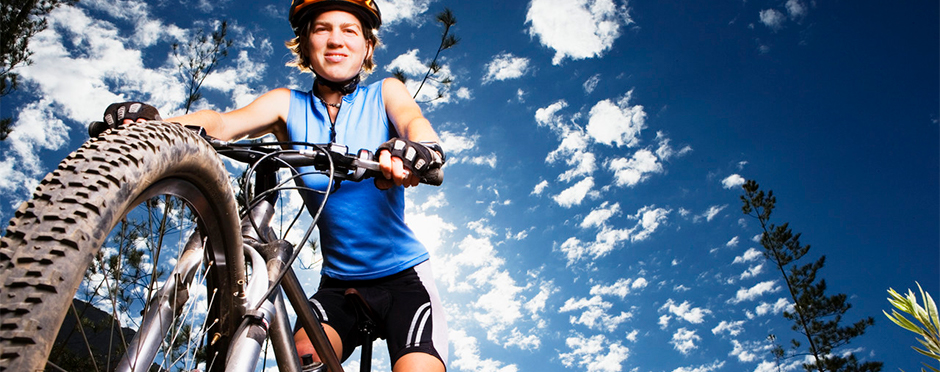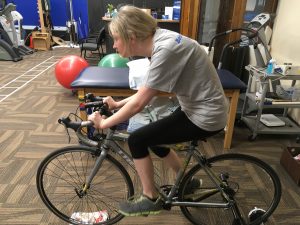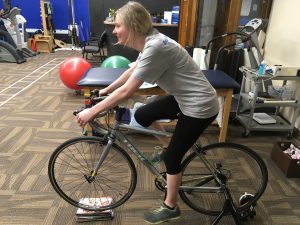
Bike Fitting Tips for Beginners
1 CommentAs we gear up for summer in the Midwest, more people will turn to biking as a way to enjoy the outdoors and stay active. In fact, statistics show that bicycling is growing as a recreational sport, with a 64 percent increase in cyclists traveling to work from 2000-2012.1
Cities are also changing their infrastructure to accommodate and promote increased ridership. For example, the city of Chicago has more than 200 miles of bike lanes, with the goal of extending this network to 645 miles by the year 2020.2 When adopting biking as a form of transportation or recreation for the first time, it is important to be prepared. Bike safety includes choosing safe routes, using proper gear and knowing how to operate the bicycle. When done correctly, biking is a great way to improve health through increased physical activity.
Unfortunately, new and experienced bicyclists are at risk for injury. The prevalence of non-traumatic bicycle injuries is at about 88 percent.3 Some of these injuries include experiencing discomfort in the neck, back, hands, hips, knees and feet.4 These problems may be remedied with a bike fitting.
The Importance of Bike Fit
Proper bike fit helps with comfort, economy and function. It is the process of adjusting a bicycle to meet individual needs at both a musculoskeletal and goal-specific level. Bike fitting also allows for efficient pedaling and safe use of the bicycle.
There are many components of a bike that may be adjusted: frame, wheels, handlebars, stems, brakehoods, seatposts, saddles and cranks to name a few. All of these may be adjusted or adapted to meet the size, strength and flexibility of the rider. Read below for some basic bike fitting tips. However, for a comprehensive evaluation that includes measurement of specific joint angles, assessment of pedaling skills and evaluation of posture, cyclists should consult a bike-fit certified physical therapist.
Frame
When choosing a bike for the first time, consider size and function. There are many different styles of bikes to meet specific needs. For example, cyclists who are interested in long distance rides for fitness should consider a road bike. Conversely, those who are interested in commuting to work, might want to consider a hybrid bike that offers more stability and comfort on uneven roads. Consult a local bike shop for specifics on the different types of bikes and frames.
Seat
Cyclists should always make sure that the seat, or saddle, of their bike is not tilted, as this may cause strain on the lower back. The seat height should be adjusted so that the rider’s knee is only slightly bent at the most extended position. Aim for 35 degrees for improved alignment and function. With the pedal at the three o’clock position, the rider’s knee should be just above the pedal. This will help prevent knee strain and injury.5


Handlebars
Cyclists should make sure that they don’t have to reach too far or too low to access their bike’s handlebars, especially if they have a history of back pain. Assuming a more upright posture by increasing the height of the handlebars will be beneficial to reduce strain on the low back and to help visualize the road. Cyclists should also use a neutral grip with their elbows slightly bent to help absorb the shock of the road. This will reduce strain of the shoulder joint when hitting potholes and bumps.
Pedaling
It is important to have good pedaling mechanics for safe and efficient riding. Cyclists should make sure the ball of the foot is positioned over the pedal spindle and choose a shoe with a stiff sole for the best leverage.
Another good tip is to choose a gear that allows for pedaling at 80-90 revolutions per minute (RPM) to lessen chance of injury.5 To avoid an overuse injury, do not use big gears at low cadences or RPM.4 It takes time and practice to develop these skills.
Posture
Adequate strength and flexibility are crucial. Cyclists should stretch their hamstrings, quadriceps and gluteal muscles because these muscles generate most of the force of pedaling. Working on balance and coordination can help with skills such as turning and breaking.4
In general, it is important to keep a relaxed grip of the handlebars and change hand positions frequently. Cyclists should also engage their lower back muscles to avoid shifting too much weight into the handlebars. Also, avoid rocking the hips and try to use both legs evenly while pedaling.

Example of Bad Posture

Example of Good Posture
Enjoy Cycling and Avoid Injuries
Cycling should be fun, not painful. With proper bike fit, cyclists can avoid overuse injuries and have a more enjoyable experience. If an injury occurs while riding, make sure to schedule an appointment for a free assessment at your nearest Athletico location.
The Athletico blog is an educational resource written by Athletico employees. Athletico bloggers are licensed professionals who abide by the code of ethics outlined by their respective professional associations. The content published in blog posts represents the opinion of the individual author based on their expertise and experience. The content provided in this blog is for informational purposes only, does not constitute medical advice and should not be relied on for making personal health decisions.
References:
1. Lee, Amy. “Bicyclists.” NHTSA. NHTSA.gov, 14 Feb. 2017. Web. 23 Apr. 2017.
2. Chicago Department of Transportation. Chicago Streets for Cycling 2020(n.d.): n. pag. Department of Transportation. CDOT, 1 Jan. 2015. Web. 23 Apr. 2017.
3. Walt, Alta Van Der, Dina Christina Janse Van Rensburg, Lizelle Fletcher, Catharina Cornelia Grant, and Andrew John Van Der Walt. “Non-traumatic Injury Profile of Amateur Cyclists.” South African Journal of Sports Medicine4 (2014): 119-22. Web.
4. Moen, Erik, PT. “How to Get an Overuse Injury.” How to Get an Overuse Injury: Common Mistakes in Endurance Cycling. BikePT, 18 Nov. 2011. Web. 23 Apr. 2017.
5. Bellamy, Jason. “Physical Therapists Offer Tips for Proper Bike Fit.” American Physical Therapy Association. APTA, 13 May 2009. Web. 23 Apr. 2017.

1 Comment
Maria Juarez
Hello, can I get more information in this? I am a manufacturing facility, and we are trying to promote wellness.